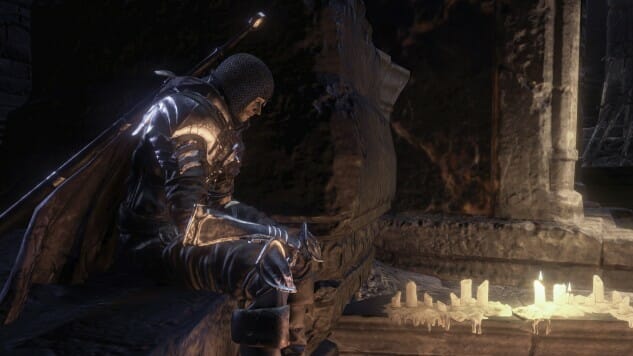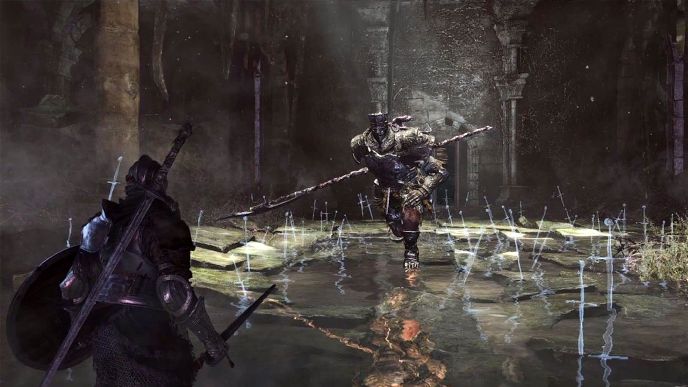Dark Souls III: Committed to Memory

For as much players tend to mythologize and fear the difficulty of the Souls games (which includes honorary member Bloodborne) I think they have always been more afraid of us. I’ve written before that these games have always tried to rework themselves to keep players in the dark. They beat players down, throw nasty surprises their way, obscure their plots, and throw in new kinks with each entry. Dark Souls turned Demon’s Souls level structure on its head by making its world one interconnected landmass; Dark Souls 2 made multiplayer a much bigger deal; Bloodborne threw aside the safety of a raised shield and pushed a more aggressive mindset. The worst thing a Souls game can do is only show you something you’ve seen before.
But those pivots have always served to deflect from the idea that these games all rely on a very familiar skillset. You find an enemy and target them. You roll out of the way of their spear and hit them with a weapon of your own. You enter an unfamiliar area expecting it to be as dangerous as the last one, so you raise your shield and head forward with trepidation. You spot out a boss’ patterns and wait for the right time to roll, block or parry their moves. Maybe there’s a “hidden” solution to killing a boss, and you figure that out. You smack at every wall you can find, hoping it’s a illusory one hiding treasure. You work your way down one path, only to find a dead end leading you back to where you started from. The rules may change between entries, but the techniques are the same. If a game didn’t throw a spanner into these works, someone might get bored. That’s what these games have always been afraid of.
Dark Souls III is the first game in the series to finally let go of that fear and embrace its familiarity. If we tear the game down into bullet points, it doesn’t bring a lot of new ideas to the table. Instead, it mashes together ideas from the rest of the series. Demon’s Souls’ mana gauge and central hub area return; you teleport among bonfires from the start of the game and upgrade your Estus Flasks the same way you did in Dark Souls II; every weapon you find has a new “Weapon Skill,” a nod to Bloodborne’s transforming swords and whips.
Dark Souls III is series developer From Software’s retrospective of its own series, and the homages are more than rule changes. An enormous dragon blocks a key doorway, roasting all the skeletal figures below them. There’s a roof full of archers with spear-sized arrows that will knock you off said roof. Priestesses resembling Mind Flayers patrol the halls of a dimly-lit prison. You trudge through poisonous swamp and framerate slows down. A ramshackle village at twilight evokes Hemwick Charnel Lane. The game’s biggest surprises don’t come from fighting a new enemy or figuring out an intricate puzzle, but recognizing something you’ve already seen. This whole game feels familiar.

That’s a little disappointing, considering From has always found some fundamental change to make each game unique. But without having to worry about adding a new hook, Dark Souls III can focus on building on the foundation of the series instead of shaking it. Before, it felt like the first half a Souls involved figuring out the new rules. This feels like the sequel to the original Dark Souls that neither Dark Souls II nor Bloodborne strived to be. Now that it can rely on players to find their footing in less time, Dark Souls III can focus on tweaking and editing with nuance.
This is what lets it revisit those ideas, building on them enough to make them feel worth playing again. The prison area feels as oppressive as it did in Demon’s Souls, but working through it is a hassle for the right reasons. In reworking bits from past games, Dark Souls III becomes the smoothest, most well put-together game in the series. Because let’s be honest, these games have always had obvious weak spots: everything after Anor Londo in Dark Souls. Demon’s Souls’ inventory and item system. Dark Souls 2’s bloat and lack of real home-run moments. Bloodborne’s limited combat options. Dark Souls III builds on its history and is a better game for it. Even the poison swamp area feels right this time around, and it doesn’t have any superfluous areas like Dark Souls’ Ash Lake.